Genomic Identification and Expression Analysis of the Cathelicidin Gene Family of the Forest Musk Deer
Simple Summary
Abstract
1. Introduction
2. Materials and Methods
2.1. Discovery of Cathelicidin Genes in the Musk Deer
2.2. Collection of Tissues
2.3. RNA Extraction and Real-Time PCR
2.4. Multiple Sequence Alignment and Phylogenetic Analysis
2.5. Comparison of the CATHL3L2 C-Terminus of the Forest Musk Deer and Cattle
2.6. Statistical Analysis
3. Results
3.1. Identification of the Forest Musk Deer Cathelicidin Genes
3.2. Phylogenetic Analysis of the Forest Musk Deer Cathelicidins
3.3. Comparison of the C-Terminus of the Forest Musk Deer CATHL3L2 and Cattle CATHL3L2p
3.4. Gene and Genome Organization of the Forest Musk Deer Cathelicidin Gene Family
3.5. Tissue Expression Pattern of Forest Musk Deer Cathelicidins
4. Discussion
5. Conclusions
Supplementary Materials
Author Contributions
Funding
Conflicts of Interest
References
- Gang, Y.; Wang, B.B. Low population density of the endangered forest musk deer, Moschus berezovskii, in China. Pak. J. Zool. 2015, 47, 325–333. [Google Scholar]
- Guha, S.; Goyal, S.; Kashyap, V. Molecular phylogeny of musk deer: A genomic view with mitochondrial 16S rRNA and cytochrome b gene. Mol. Phylogenet. Evol. 2007, 42, 585–597. [Google Scholar] [CrossRef] [PubMed]
- Zhou, C.; Zhang, W.; Wen, Q.; Bu, P.; Gao, J.; Wang, G.; Jin, J.; Song, Y.; Sun, X.; Zhang, Y.; et al. Comparative Genomics Reveals the Genetic Mechanisms of Musk Secretion and Adaptive Immunity in Chinese Forest Musk Deer. Genome Boil. Evol. 2019, 11, 1019–1032. [Google Scholar] [CrossRef] [PubMed]
- Meng, X.; Gong, B.; Ma, G.; Xiang, L. Quantified Analyses of Musk Deer Farming in China: A Tool for Sustainable Musk Production and Ex situ Conservation. Asian Australas. J. Anim. Sci. 2011, 24, 1473–1482. [Google Scholar] [CrossRef]
- Lv, X.-H.; Qiao, J.-Y. A Review of Mainly Affected on Musk-Deer Diseases: Purulent, Respiratory System and Parasitic Diseases. J. Econ. Anim. 2009, 13, 104–106. [Google Scholar]
- Zhao, K.-L.; Wang, H.-N.; Yue, B.-S.; Liu, Y.; Zhang, X.-Y.; Palahati, P. Detection and characterization of antibiotic-resistance genes in Arcanobacterium pyogenes strains from abscesses of forest musk deer. J. Med. Microbiol. 2011, 60, 1820–1826. [Google Scholar] [CrossRef] [PubMed]
- Ganz, T. Defensins: Antimicrobial peptides of vertebrates. C. R. Boil. 2004, 327, 539–549. [Google Scholar] [CrossRef]
- Thomma, B.P.; Cammue, B.P. Plant defensins. Planta 2002, 216, 193–202. [Google Scholar] [CrossRef] [PubMed]
- Yu, L.-T.; Xiao, Y.-P.; Li, J.-J.; Ran, J.-S.; Yin, L.-Q.; Liu, Y.-P.; Zhang, L. Molecular characterization of a novel ovodefensin gene in chickens. Gene 2018, 678, 233–240. [Google Scholar] [CrossRef] [PubMed]
- Hilchie, A.L.; Wuerth, K.; Hancock, R.E.W. Immune modulation by multifaceted cationic host defense (antimicrobial) peptides. Nat. Methods 2013, 9, 761–768. [Google Scholar] [CrossRef]
- Uzzell, T.; Stolzenberg, E.D.; E Shinnar, A.; Zasloff, M. Hagfish intestinal antimicrobial peptides are ancient cathelicidins. Peptides 2003, 24, 1655–1667. [Google Scholar] [CrossRef] [PubMed]
- Agerberth, B.; Gunne, H.; Odeberg, J.; Kogner, P.; Boman, H.G.; Gudmundsson, G.H. FALL-39, a putative human peptide antibiotic, is cysteine-free and expressed in bone marrow and testis. Proc. Natl. Acad. Sci. USA 1995, 92, 195–199. [Google Scholar] [CrossRef] [PubMed]
- Zhao, H.; Gan, T.-X.; Liu, X.-D.; Jin, Y.; Lee, W.-H.; Shen, J.-H.; Zhang, Y. Identification and characterization of novel reptile cathelicidins from elapid snakes. Peptides 2008, 29, 1685–1691. [Google Scholar] [CrossRef] [PubMed]
- Ishige, T.; Hara, H.; Hirano, T.; Kono, T.; Hanzawa, K. Characterization of the cathelicidin cluster in the Japanese quail (Coturnix japonica). Anim. Sci. J. 2017, 88, 1249–1257. [Google Scholar] [CrossRef] [PubMed]
- Zanetti, M. Cathelicidins, multifunctional peptides of the innate immunity. J. Leukoc. Biol. 2004, 75, 39–48. [Google Scholar] [CrossRef]
- Kosciuczuk, E.M.; Lisowski, P.; Jarczak, J.; Strzałkowska, N.; Jozwik, A.; Horbańczuk, J.O.; Krzyżewski, J.; Zwierzchowski, L.; Bagnicka, E. Cathelicidins: Family of antimicrobial peptides. A review. Mol. Boil. Rep. 2012, 39, 10957–10970. [Google Scholar] [CrossRef]
- Xiao, Y.; Cai, Y. Identification and functional characterization of three chicken cathelicidins with potent antimicrobial activity. J. Biol. Chem. 2006, 281, 2858–2867. [Google Scholar] [CrossRef]
- Zelezetsky, I.; Pontillo, A. Evolution of the primate cathelicidin. Clin. Microbiol. Infect. Suppl. 2005, 11, 83–84. [Google Scholar]
- Whelehan, C.J.; Barry-Reidy, A.; Meade, K.G.; Eckersall, P.D.; Chapwanya, A.; Narciandi, F.; Lloyd, A.T.; O’Farrelly, C. Characterisation and expression profile of the bovine cathelicidin gene repertoire in mammary tissue. BMC Genom. 2014, 15, 128. [Google Scholar] [CrossRef]
- Young-Speirs, M.; Drouin, D.; Cavalcante, P.A.; Barkema, H.W.; Cobo, E.R. Host defense cathelicidins in cattle: Types, production, bioactive functions and potential therapeutic and diagnostic applications. Int. J. Antimicrob. Agents 2018, 51, 813–821. [Google Scholar] [CrossRef]
- Fan, Z.; Li, W.; Jin, J.; Cui, K.; Yan, C.; Peng, C.; Jian, Z.; Bu, P.; Price, M.; Zhang, X.; et al. The draft genome sequence of forest musk deer (Moschus berezovskii). GigaScience 2018, 7, 1–6. [Google Scholar] [CrossRef] [PubMed]
- Zhang, L.; Chen, D.; Yu, L.; Wei, Y.; Li, J.; Zhou, C. Genome-wide analysis of the ovodefensin gene family: Monophyletic origin, independent gene duplication and presence of different selection patterns. Infect. Genet. Evol. 2019, 68, 265–272. [Google Scholar] [CrossRef] [PubMed]
- El-Gebali, S.; Mistry, J.; Bateman, A.; Eddy, S.R.; Luciani, A.; Potter, S.C.; Qureshi, M.; Richardson, L.J.; A Salazar, G.; Smart, A.; et al. The Pfam protein families database in 2019. Nucleic Acids Res. 2018, 47, D427–D432. [Google Scholar] [CrossRef] [PubMed]
- Altschul, S.F.; Gish, W. Basic local alignment search tool. J. Mol. Biol. 1990, 215, 403–410. [Google Scholar] [CrossRef]
- Yan, H.; Zhang, L.; Guo, Z.; Zhang, H.; Liu, J. Production Phase Affects the Bioaerosol Microbial Composition and Functional Potential in Swine Confinement Buildings. Animals 2019, 9, 90. [Google Scholar] [CrossRef] [PubMed]
- Birney, E.; Clamp, M. GeneWise and Genomewise. Genome Res. 2004, 14, 988–995. [Google Scholar] [CrossRef] [PubMed]
- Burge, C.B.; Karlin, S. Finding the genes in genomic DNA. Curr. Opin. Struct. Biol. 1998, 8, 346–354. [Google Scholar] [CrossRef]
- Chen, M.; Jie, H.; Xu, Z.; Ma, T.; Lei, M.; Zeng, D.; Zhao, G.; Feng, X.; Zheng, C.; Zhang, C.; et al. Isolation, primary culture, and morphological characterization of gland epithelium from forest musk deer (Moschus berezovskii). Vitr. Cell. Dev. Boil. Anim. 2018, 54, 545–548. [Google Scholar] [CrossRef]
- Yan, H.; Cao, S.; Li, Y.; Zhang, H.; Liu, J. Reduced meal frequency alleviates high-fat diet-induced lipid accumulation and inflammation in adipose tissue of pigs under the circumstance of fixed feed allowance. Eur. J. Nutr. 2019, 1–14. [Google Scholar] [CrossRef]
- Liu, J.; Zhang, Y.; Li, Y.; Yan, H.; Zhang, H. L-tryptophan Enhances Intestinal Integrity in Diquat-Challenged Piglets Associated with Improvement of Redox Status and Mitochondrial Function. Animals 2019, 9, 266. [Google Scholar] [CrossRef]
- Livak, K.J.; Schmittgen, T.D. Analysis of Relative Gene Expression Data Using Real-Time Quantitative PCR and the 2−ΔΔCT Method. Methods 2001, 25, 402–408. [Google Scholar] [CrossRef] [PubMed]
- Edgar, R.C. MUSCLE: Multiple sequence alignment with high accuracy and high throughput. Nucleic Acids Res. 2004, 32, 1792–1797. [Google Scholar] [CrossRef] [PubMed]
- Kumar, S.; Stecher, G.; Tamura, K. MEGA7: Molecular Evolutionary Genetics Analysis version 7.0 for bigger datasets. Mol. Boil. Evol. 2016, 33, 1870–1874. [Google Scholar] [CrossRef] [PubMed]
- Hedges, S.B.; Marin, J.; Suleski, M.; Paymer, M.; Kumar, S. Tree of Life Reveals Clock-Like Speciation and Diversification. Mol. Boil. Evol. 2015, 32, 835–845. [Google Scholar] [CrossRef] [PubMed]
- Sang, Y.; Ortega, M.T.; Rune, K.; Xiau, W.; Zhang, G.; Soulages, J.L.; Lushington, G.H.; Fang, J.; Williams, T.D.; Blecha, F. Canine cathelicidin (K9CATH): Gene cloning, expression, and biochemical activity of a novel pro-myeloid antimicrobial peptide. Dev. Comp. Immunol. 2007, 31, 1278–1296. [Google Scholar] [CrossRef] [PubMed]
- Zhu, S. Did cathelicidins, a family of multifunctional host-defense peptides, arise from a cysteine protease inhibitor? Trends Microbiol. 2008, 16, 353–360. [Google Scholar] [CrossRef] [PubMed]
- Zhu, S.; Gao, B. A fossil antibacterial peptide gives clues to structural diversity of cathelicidin-derived host defense peptides. FASEB J. 2009, 23, 13–20. [Google Scholar] [CrossRef] [PubMed]
- Islam, D.; Bandholtz, L.; Nilsson, J.; Wigzell, H.; Christensson, B.; Agerberth, B.; Gudmundsson, G.H. Downregulation of bactericidal peptides in enteric infections: A novel immune escape mechanism with bacterial DNA as a potential regulator. Nat. Med. 2001, 7, 180–185. [Google Scholar] [CrossRef] [PubMed]
- Sun, X.; Cai, R.; Jin, X.; Shafer, A.B.A.; Hu, X.; Yang, S.; Li, Y.; Qi, L.; Liu, S.; Hu, D. Blood transcriptomics of captive forest musk deer (Moschus berezovskii) and possible associations with the immune response to abscesses. Sci. Rep. 2018, 8, 599. [Google Scholar] [CrossRef]
- Zhao, W.; Tian, Q.; Luo, Y.; Wang, Y.; Yang, Z.-X.; Yao, X.-P.; Cheng, J.-G.; Zhou, X.; Wang, W.-Y. Isolation, identification, and genome analysis of lung pathogenic klebsiella pneumoniae (lpkp) in forest musk deer. J. Zoo Wildl. Med. 2017, 48, 1039–1048. [Google Scholar] [CrossRef]
- Ashby, M.; Petkova, A. Cationic antimicrobial peptides as potential new therapeutic agents in neonates and children: A review. Curr. Opin. Infect. Dis. 2014, 27, 258–267. [Google Scholar] [CrossRef] [PubMed]
- Brogden, K.A. Antimicrobial peptides: Pore formers or metabolic inhibitors in bacteria? Nat. Rev. Genet. 2005, 3, 238–250. [Google Scholar] [CrossRef]
- Baumann, A.; Kiener, M.S.; Haigh, B.; Perreten, V.; Summerfield, A. Differential Ability of Bovine Antimicrobial Cathelicidins to Mediate Nucleic Acid Sensing by Epithelial Cells. Front. Immunol. 2017, 8, 173. [Google Scholar] [CrossRef]
- Shamova, O.; Brogden, K.A.; Zhao, C.; Nguyen, T.; Kokryakov, V.N.; Lehrer, R.I.; McGhee, J.R. Purification and Properties of Proline-Rich Antimicrobial Peptides from Sheep and Goat Leukocytes. Infect. Immun. 1999, 67, 4106–4111. [Google Scholar] [PubMed]
- Robinson, K.; Ma, X.; Liu, Y.; Qiao, S.; Hou, Y.; Zhang, G. Dietary modulation of endogenous host defense peptide synthesis as an alternative approach to in-feed antibiotics. Anim. Nutr. 2018, 4, 160–169. [Google Scholar] [CrossRef] [PubMed]
- Cai, S.; Qiao, X.; Feng, L.; Shi, N.; Wang, H.; Yang, H.; Guo, Z.; Wang, M.; Chen, Y.; Wang, Y.; et al. Python Cathelicidin CATHPb1 Protects against Multidrug-Resistant Staphylococcal Infections by Antimicrobial-Immunomodulatory Duality. J. Med. Chem. 2018, 61, 2075–2086. [Google Scholar] [CrossRef]
- Feng, F.; Chen, C.; Zhu, W.; He, W.; Guang, H.; Li, Z.; Wang, D.; Liu, J.; Chen, M.; Wang, Y.; et al. Gene cloning, expression and characterization of avian cathelicidin orthologs, Cc-CATHs, from Coturnix coturnix. FEBS J. 2011, 278, 1573–1584. [Google Scholar] [CrossRef] [PubMed]
- Liu, J.B.; Yan, H.L.; Zhang, Y.; Hu, Y.D.; Zhang, H.F. Effects of dietary energy and protein content and lipid source on growth performance and carcass traits in Pekin ducks. Poult. Sci. 2019. [Google Scholar] [CrossRef] [PubMed]
- Xue, P.; Cao, S.; Chen, L.; Zhang, H.; Liu, J. Effects of dietary phosphorus concentration and body weight on postileal phosphorus digestion in pigs. Anim. Feed. Sci. Technol. 2018, 242, 86–94. [Google Scholar]
- Yan, H.; Cao, S.; Zhang, H.; Liu, J.; Liu, J. Effect of feed intake level on the determination of apparent and standardized total tract digestibility of phosphorus for growing pigs. Anim. Feed. Sci. Technol. 2018, 246, 137–143. [Google Scholar]
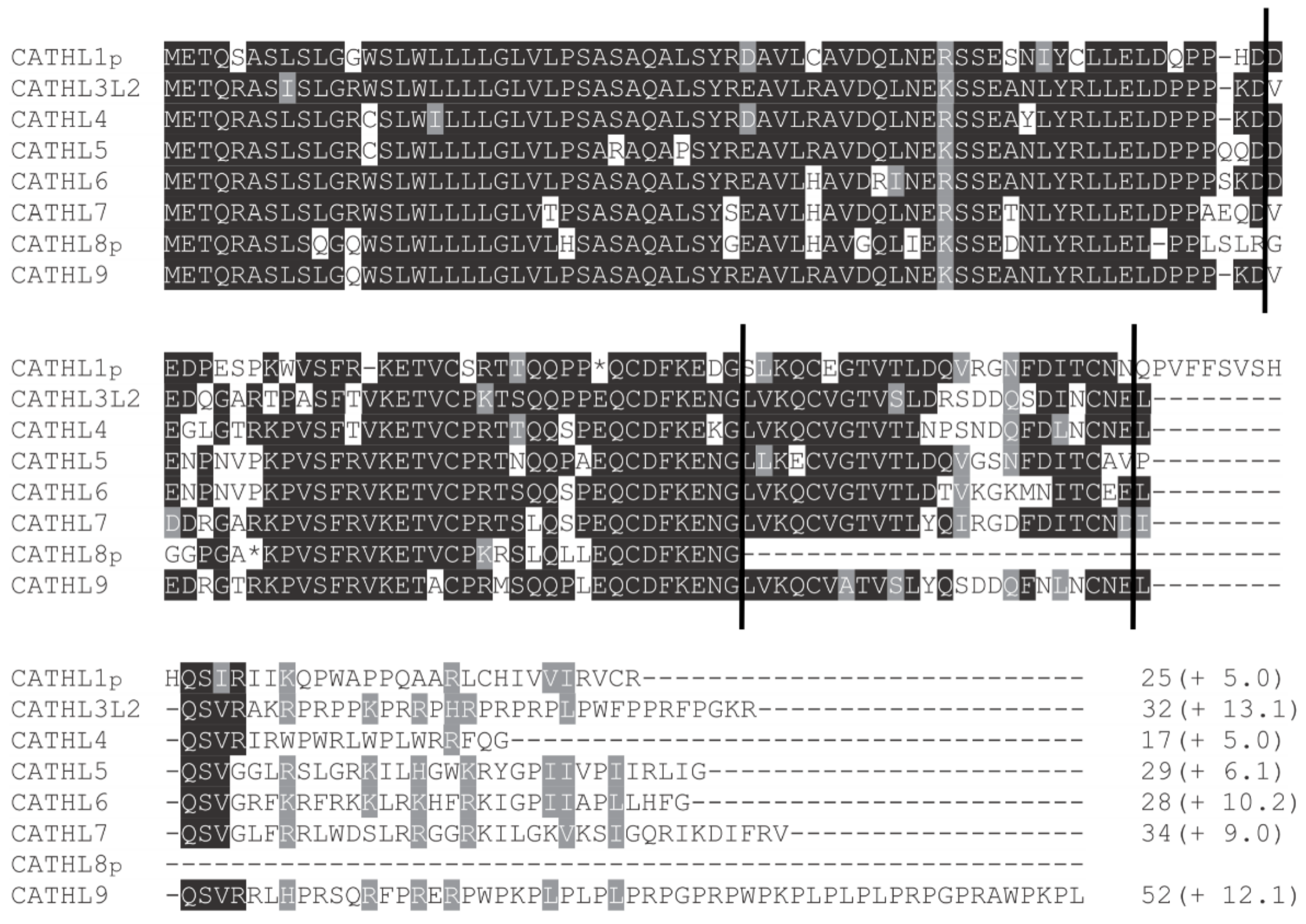
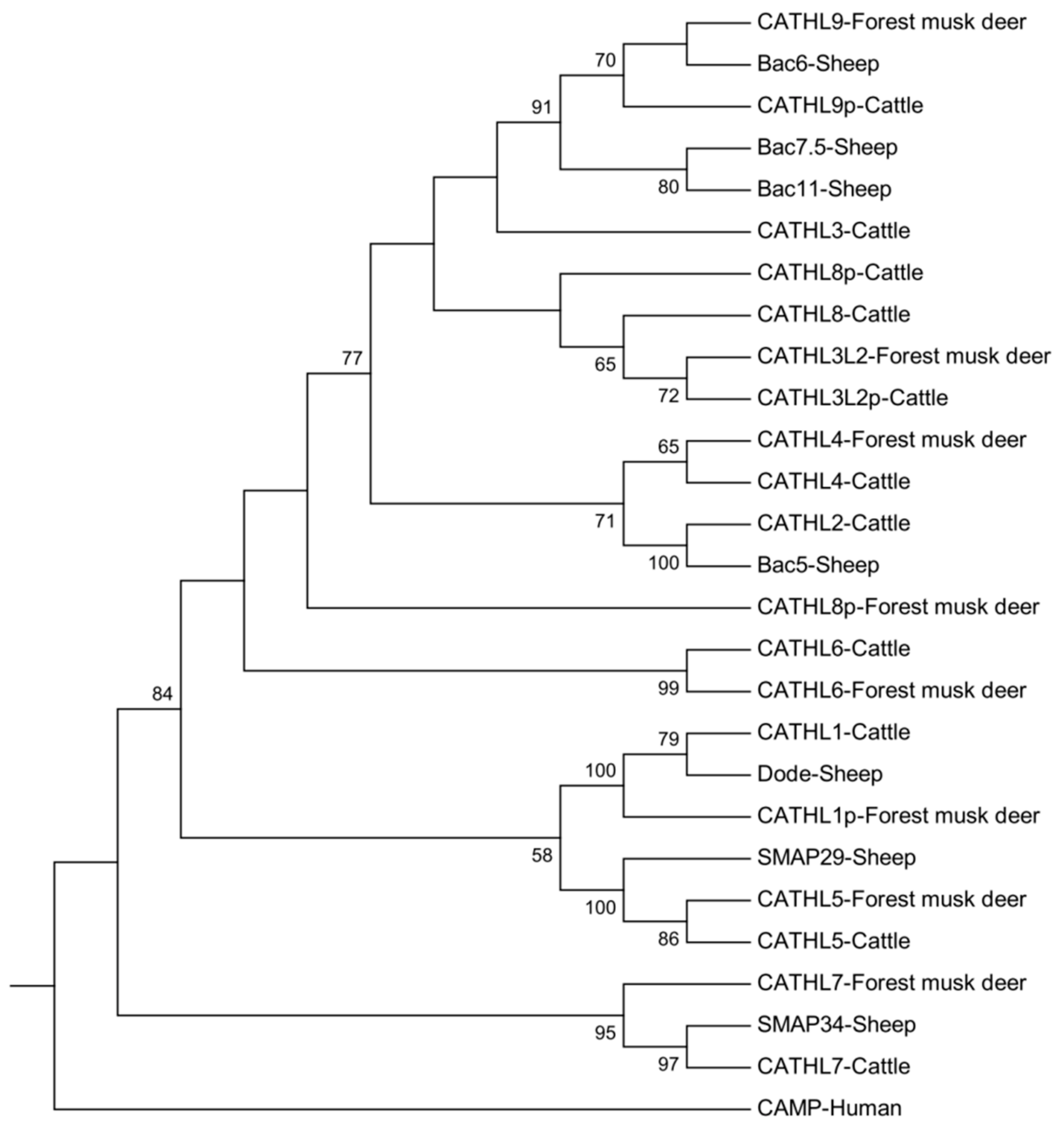
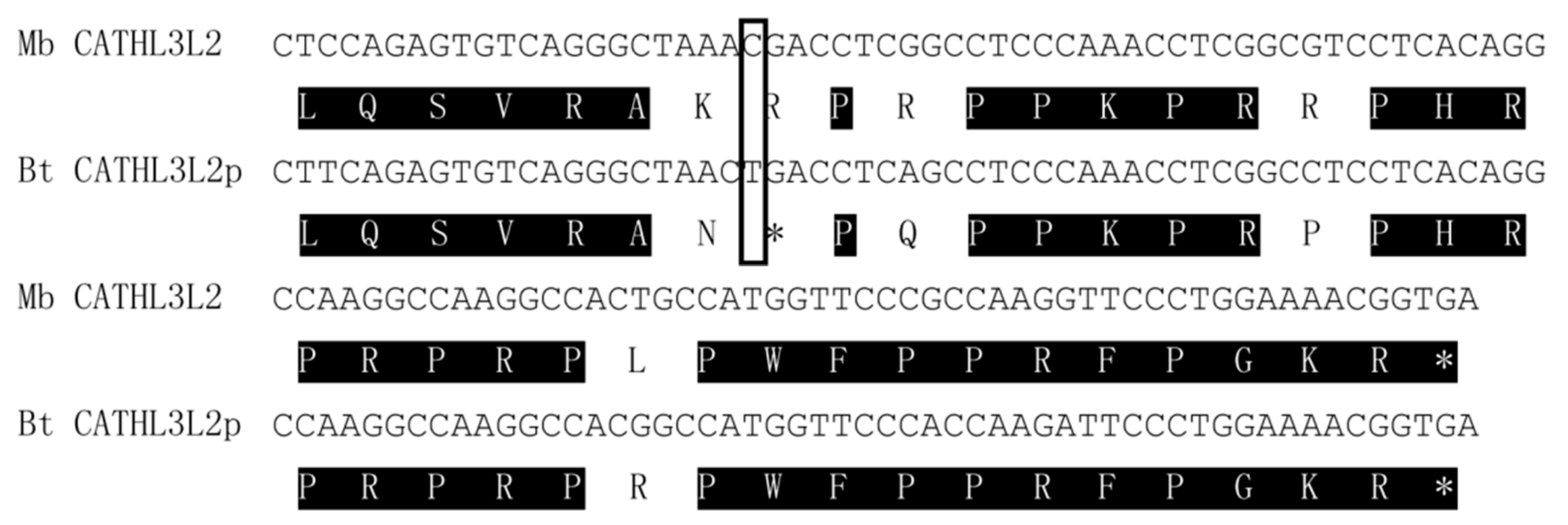
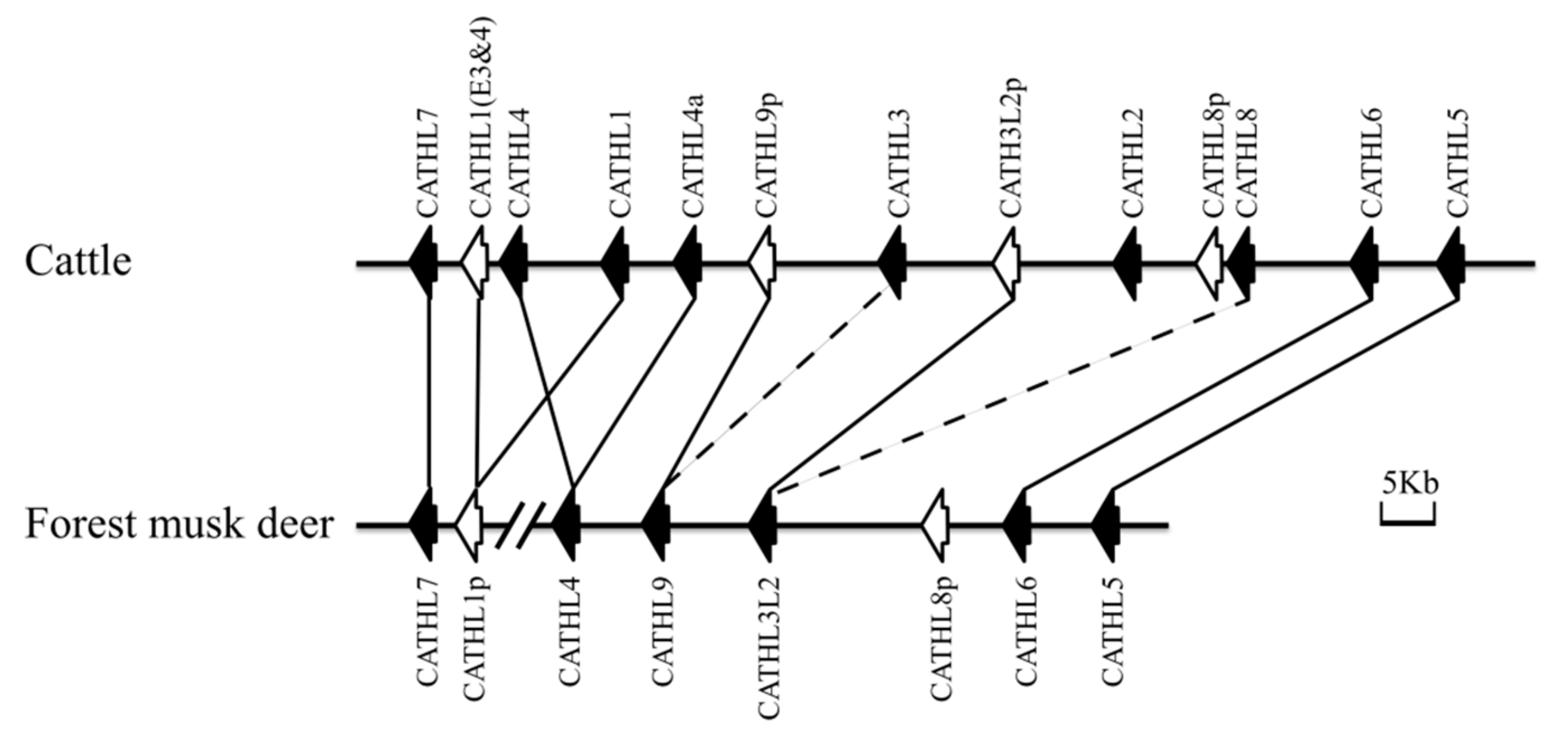
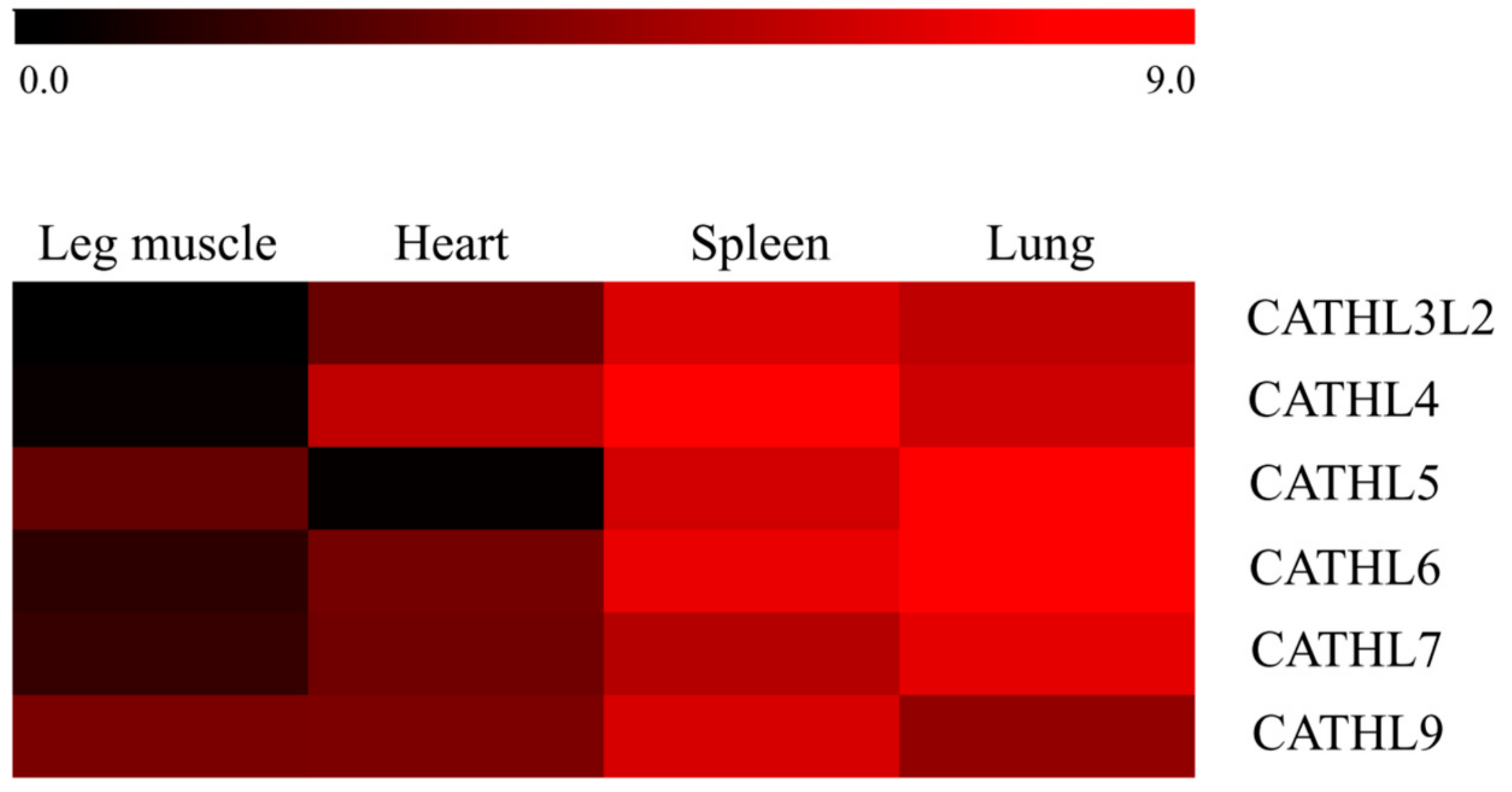

| Gene | Forward Primer | Reverse Primer | Fragment Length (bp) | Annealing Temperature (°C) |
|---|---|---|---|---|
| CATHL1p | CTACAGGGACGCCGTGCTTT | GGGCTTTCTGGGTCTTCATCAT | 120 | 60 |
| CATHL3L2 | CAGAGCAATGTGACTTCAAGGAGA | GGTCGTTTAGCCCTGACACTCTG | 127 | 60 |
| CATHL4 | CCCGGAGCAGTGTGACTTCAA | CTGGTCATTGGACGGGTTCAG | 82 | 60 |
| CATHL5 | GGTCGGGAGTAACTTCGACATTAC | GGCCATACCTCTTCCAACCAT | 101 | 60 |
| CATHL6 | CCAAGGACGATGAGAACCCAA | GTCCAGAGTGACTGTCCCCACA | 152 | 60 |
| CATHL7 | CCCAGGCCCTCAGCTACAGT | CTCACAGGCTTTCGAGCACCA | 148 | 60 |
| CATHL9 | GGGGAACTCGAAAGCCTGTGA | CACACTGTTTTACCAGCCCATTCT | 114 | 60 |
| GAPDH | GCAAGTTCAACGGCACAGTCA | CTGGTTCACGCCCATCACAA | 249 | 60 |
| Gene | Scaffold | Gene Size (bp) 1 | ||||||
|---|---|---|---|---|---|---|---|---|
| E 1 | I 1 | E 2 | I 2 | E 3 | I 3 | E 4 | ||
| CATHL1p | Scaffold41 | 198 | 115 | 107 | 150 | 72 | 561 | 117 |
| CATHL3L2 | Scaffold511 | 198 | 624 | 108 | 157 | 72 | 602 | 171 |
| CATHL4 | Scaffold511 | 198 | 106 | 108 | 137 | 72 | 603 | 66 |
| CATHL5 | Scaffold511 | 201 | 611 | 108 | 163 | 72 | 597 | 102 |
| CATHL6 | Scaffold511 | 201 | 614 | 108 | 139 | 72 | 600 | 99 |
| CATHL7 | Scaffold41 | 201 | 620 | 108 | 154 | 72 | 600 | 117 |
| CATHL8p | Scaffold511 | 198 | 579 | 108 | NA | NA | NA | NA |
| CATHL9 | Scaffold511 | 198 | 623 | 108 | 165 | 72 | 601 | 111 |
© 2019 by the authors. Licensee MDPI, Basel, Switzerland. This article is an open access article distributed under the terms and conditions of the Creative Commons Attribution (CC BY) license (http://creativecommons.org/licenses/by/4.0/).
Share and Cite
Zhang, L.; Jie, H.; Xiao, Y.; Zhou, C.; Lyu, W.; Bai, W. Genomic Identification and Expression Analysis of the Cathelicidin Gene Family of the Forest Musk Deer. Animals 2019, 9, 481. https://doi.org/10.3390/ani9080481
Zhang L, Jie H, Xiao Y, Zhou C, Lyu W, Bai W. Genomic Identification and Expression Analysis of the Cathelicidin Gene Family of the Forest Musk Deer. Animals. 2019; 9(8):481. https://doi.org/10.3390/ani9080481
Chicago/Turabian StyleZhang, Long, Hang Jie, Yingping Xiao, Caiquan Zhou, Wentao Lyu, and Wenke Bai. 2019. "Genomic Identification and Expression Analysis of the Cathelicidin Gene Family of the Forest Musk Deer" Animals 9, no. 8: 481. https://doi.org/10.3390/ani9080481
APA StyleZhang, L., Jie, H., Xiao, Y., Zhou, C., Lyu, W., & Bai, W. (2019). Genomic Identification and Expression Analysis of the Cathelicidin Gene Family of the Forest Musk Deer. Animals, 9(8), 481. https://doi.org/10.3390/ani9080481





